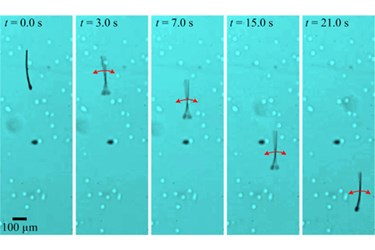Sperm-Inspired Micro-Robots For Drug Delivery, IVF, Clearing Blocked Arteries?
By Joel Lindsey

Scientists from the German University in Cairo and the University of Twente in the Netherlands have created tiny medical micro-robots modeled after sperm. These new robots could effectively navigate throughout the human body in order to perform a host of medical-related functions.
“The applications of this micro-robot are diverse,” Sarthak Misra, an associate professor of robotics and mechatronics at the University of Twente who is involved with the project, said in an article published by IT World. “These include targeted drug delivery, in vitro fertilization, cell sorting, and cleaning of clogged arteries, among others.”
The new device, called MagnetoSperm, is 322 microns long and features a head that has been coated in nickel-cobalt and a non-coated polymer tail. Because the head is magnetic, when a fluctuating weak magnetic force is applied, the top of the robot reacts in such a way that causes the whip-like tail to undulate like a propeller, moving the robot forward.
Researchers involved with the project say these tiny robots could be implanted and then moved to precise locations within a person’s body through magnetic manipulation. Early tests have indicated that the robots can move at a maximum speed of 160 micrometers per second.
After successfully demonstrating the ability of the MagnetoSperm to effectively and precisely move about, scientists plan on working to further reduce the size of the robots, which could allow them to navigate even the tiniest of human blood vessels. They are also working to synthesize drug payloads so that the robots might be able to release them as close as possible to diseased or infected cells.
“This would allow us to achieve targeted therapy to mitigate the negative side effects of conventional chemotherapy,” Islam S.M. Khalil, an assistant professor of engineering and material science at German University in Cairo, said about one possible use of the micro-robots.
Details regarding the design and functionality of the MagnetoSperm, along with results from early experiments, have been published recently in the journal Applied Physics Letters.
“Although electromagnetic and magnetic micro-robots have been an area of great scrutiny in the past, the bots’ inability to travel far has held the use of this type of research at bay,” Korrey Laderoute wrote in an opinion piece published by the Guardian Liberty Voice. “With the realization of how live micro-organisms work, such as sperm cells and bacteria, the scientists built robots and modeled them after sperm to be used in various medical treatments ... they state that their robots are influenced directly from nature because the natural world has designed the most efficient ways for locomotion at the microscopic level.”
Image credit: I.S.M. Khalil/GUC & S. Misra/U.Twente
